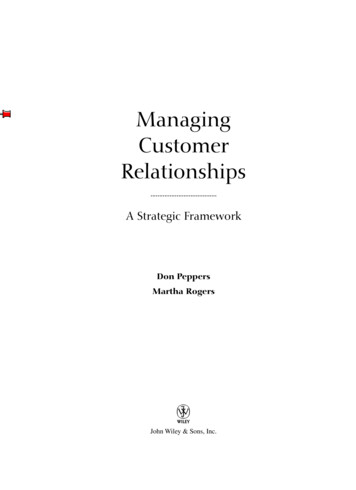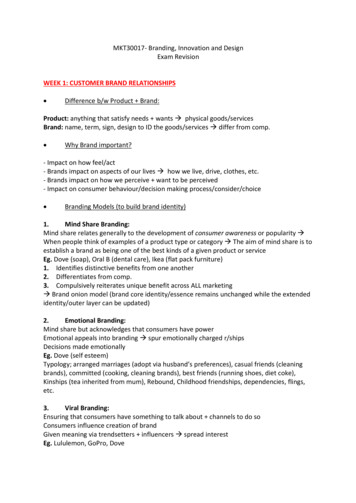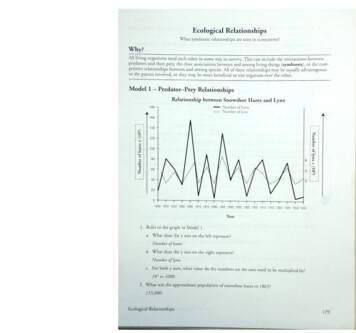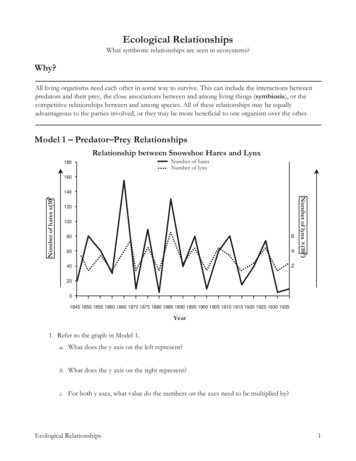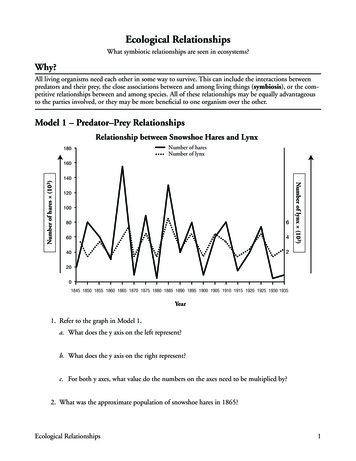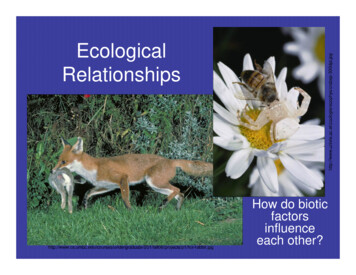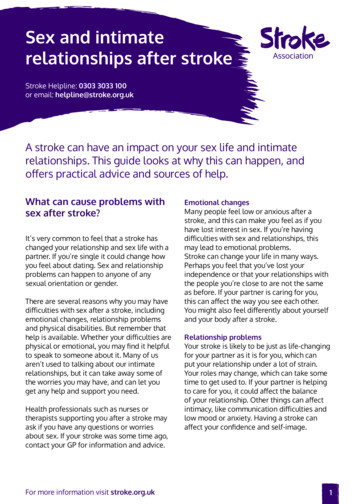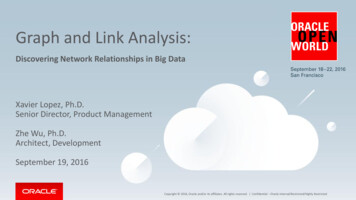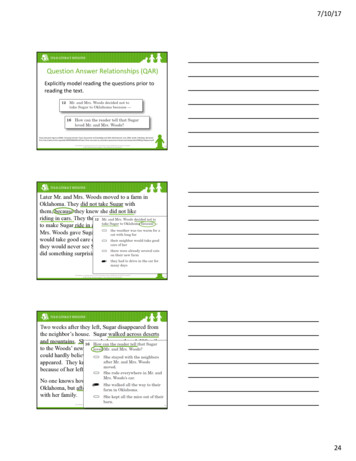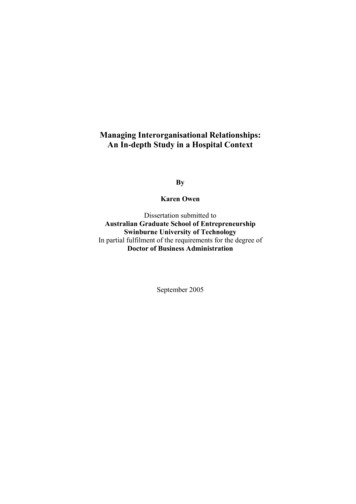
Transcription
Managing Interorganisational Relationships:An In-depth Study in a Hospital ContextByKaren OwenDissertation submitted toAustralian Graduate School of EntrepreneurshipSwinburne University of TechnologyIn partial fulfilment of the requirements for the degree ofDoctor of Business AdministrationSeptember 2005
ABSTRACTCan interorganisational relationships be managed for effective functioning? This isthe problem investigated in this research. Organisations world-wide are adoptingco-operative relationships with other organisations. These interorganisationalrelationships are viewed as a way to enhance their own business performance(Williamson 1985, 1991; Dyer 1997; Gulati 1998; Barringer & Harrison 2000; Das& Teng 2000; Quinn 2000; Stuart 2000; Johnson, Korsgaard & Sapienza 2002).Despite this, the success rate for interorganisational relationships is not high (Hutt,Stafford, Walker & Reingen 2000; Quinn 2000; Hitt, Ireland & Vaidyanath 2002)with many of them failing to achieve their objectives. Understanding how tomanage these boundary-spanning arrangements is important to realising theobjectives of the business strategy.The research setting is a large private hospital in Australia. It works with anetwork of external service organisations that provide the Hospital with a range ofclinical and non-clinical support services including: Diagnostic Imaging, PathologyPharmacy, Food Services, Environmental Services, and Human Resources support.This research explores how these different relationships were managed in theiroperating period: 1998 to 2002. It reveals the dynamic and often ad hoc way, inwhich managers made sense of the collaborative service context, and howmanagers influenced the process of interorganisational relationship formation.Extant research about interorganisational relationships comes from a variety offields. For this research it is most relevant to draw from the research fields oforganisational theory, organisation behaviour, sociology, psychology andmanagement. These fields contribute findings that provide useful knowledge uponwhich to build further understanding about how managers contribute to constructinterorganisational relationships functioning (Ring & Van de Ven 1992, 1994;Walsh 1995; Chikudate 1999a, 1999b; Boddy, Macbeth & Wagner 2000; Hutt,Stafford, Walker & Reingen 2000; Lasker, Weiss & Miller 2001).ii
This research uses an interpretivist methodology that enables the researcher toexplore the dynamic nature of the Manager’s sense-making in the construction ofsix interorganisational relationships.For the purposes of this research,interorganisational relationships are defined as new structures that emerge throughthe social interaction of actors involved in shared service delivery.Thecollaborative context of interorganisational relationships stimulates managers’sense-making by challenging institutionalised ways of behaving. This sensemaking process builds new knowledge stores and contributes to emerging, newmanagement routines. The process is transformative and enables the emergence ofinterorganisational relationships.It emerges from this research that managers take cues from their context. Thesecues are used to interpret and make assessments that enable decisions about thoseactions that they take to construct the interorganisational relationships.Amanager’s processing of contextual cues, through interpretive frames anddispositional sense-making filters, is an inter-subjective, socially constructiveprocess. The ‘self’ is a dimensional influence in the managers’ sense-making andmanagement behaviours and is implicated through the notion of contextualinterpretive frames and dispositional sense-making filters.A model ofinterorganisational relationship management as a transformational process isdeveloped.The association between contextual influences and managers’behaviours will raise awareness for professional practitioners of the challengesinvolved in managing across organisational boundaries and in turn, may contributeto more successful implementation of interorganisational business relationships.iii
ACKNOWLEDGEMENTSI wish to thank all those people at the Hospital with whom I have worked in theperiod 1998 to 2002. Without this opportunity I would never have received thestimulation to undertake this study. My particular thanks go to those managerswith whom I have worked most closely and without whose support the task ofmanaging interorganisational relationships would have been even morechallenging. In particular I thank the Hospital Chief Executive who provided mewith the encouragement and support to undertake this research.Most particularly I want to thank Professor Pam Green who rescued me whenProfessor Cavaye left the University. Professor Green showed great tolerance andpatience when I was most frustrated. I am as always also indebted to my verygood friend, Merren, who has never tired of fixing up my computer mistakes.Finally I could not have completed this study without the support of Malcolm, myhusband and my beautiful daughter Melanie who has grown up while I havestudied. They have understood my need for space and time, and they have given itfreely. I appreciate their gifts and I look forward to regaining my life with themwhen this is finished.Thank you all.iv
DECLARATION BY CANDIDATEThis thesis contains no material which has been accepted for the award of anyother degree or diploma, except where due reference is made in the text of thethesis. To the best of my knowledge, this thesis contains no material previouslypublished or written by another person except where due reference is made in thetext of the thesis.Signed:Dated:v
CONTENTS12INTRODUCTION. 11.1Introduction .11.2Background to the Problem.11.3Statement of the Problem .61.4Definition of the Terms Used in the Research .71.4.1 Interorganisational Relationship .71.4.2 Functioning Interorganisational Relationship .71.4.3 Management Activity.81.4.4 Not-for-profit Organisations .81.4.5 Service Provider .91.4.6 The Client Organisation and the Hospital .91.4.7 The Manager .91.4.8 Core Business Activity.91.4.9 Near-core Clinical Support Services .101.4.10Peripheral Non-clinical Support Services .101.5Significance of the Research .101.6Brief Overview of the Research Strategy.121.6.1 Theoretical Perspective .121.6.2 Research Methodology and Methods .121.6.3 The Hospital Context .131.6.4 Private Health in Australia .151.7Interorganisational Relationships in the Australian Private Health Sector181.8Contributions of the Research .191.9Structure of the Dissertation.201.10 Chapter Summary.21REVIEW OF RELATED LITERATURE. .22.62.6.12.6.22.6.32.6.42.72.8Introduction .22Types of Interorganisational Relationships.24Joint Ventures.26Consortia .26Outsourcing .27Networks .29Strategic Alliances.31Interorganisational Relationships as ‘Organisation’ .32Structure and Socially Constructed Reality .36Sense-making .39Organisational Schema.41Routines.44Other Relevant Findings about Interorganisational Relationships.50The Notion of ‘fit’ between Organisations .51Building Relational and Social Ties.57Trust and Governance .58Client Orientation and Objectives .60Phases of Interorganisational Relationship Formation.67Chapter Summary.69vi
34RESEARCH METHODOLOGY . 713.1Introduction .713.2Tripartite Model for this Research .713.2.1 Interpretivist Theoretical Perspective.723.2.1.1Ontological Assumptions .723.2.1.2Epistemological Assumptions .733.2.2 Reflexive Interpretive Research Methodology and Methods.743.2.2.1A Reflexive Interpretive Approach .753.2.2.2Qualitative Methods .773.2.3 The Research Context .783.3The Role of the Researcher .783.3.1 Ethical Issues.803.4The Process of Enquiry .833.4.1 Entering the Field .833.4.2 Selection of Interorganisational Relationships.843.4.3 Data Collection Methods.863.4.3.1Participant Observation .863.4.3.2Interviews .883.4.3.3Additional Materials.963.5The Process of Interpretation .973.5.1 Identifying Themes .1003.6Addressing Matters of Trustworthiness .1033.6.1 Credibility.1033.7Chapter Summary.106FINDINGS: CONSTRUCTED NARRATIVES . 44.6.5Introduction .107The Context of the Narratives .107Presentation of the Constructed Narratives .109Narrative One: Diagnostic Imaging Services.111Background .111Developing the Service Agreement.112Management of the Interorganisational Relationship .115Billing.118Monitoring.119Summary: Perceptions of Interorganisational Relationship Functioning120Narrative Two: Pathology Services.122Background .122Developing the Service Agreement.123Management of t
Karen Owen Dissertation submitted to Australian Graduate School of Entrepreneurship Swinburne University of Technology In partial fulfilment of the requirements for the degree of Doctor of Business Administration September 2005 . ii ABSTRACT Can interorganisational relationships be managed for effective functioning? This is the problem investigated in this research. Organisations world-wide .

